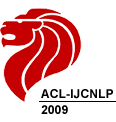TextGraphs-4: Graph-based Methods for Natural Language Processing
7th August 2009, SingaporeRecent years have shown an increased amount of interest in applying graph theoretic models to computational linguistics. Both graph theory and computational linguistics are well studied disciplines which have traditionally been perceived as distinct, embracing different algorithms, different applications, and different potential end-users. However, as recent research work has shown, the two seemingly distinct disciplines are in fact intimately connected, with a large variety of natural language processing applications adopting efficient and elegant solutions from graph-theoretical framework.
Traditional graph theory, which is studied as a sub-discipline of mathematics, has been successfully applied in modeling and solving several applications in Natural Language Processing. More recently, complex network theory, a popular modeling paradigm in statistical mechanics and physics of complex systems, was proven to be a promising tool in understanding the structure and dynamics of languages. Complex network based models have been applied to areas as diverse as language evolution, acquisition, historical linguistics, mining and analyzing the social networks of blogs and emails, link analysis and information retrieval, information extraction, and representation of the mental lexicon.
Similarly, in many NLP applications entities can be naturally represented as nodes in a graph and relations between them can be represented as edges. Recent research has shown that graph-based representations of linguistic units as diverse as words, sentences and documents give rise to novel and efficient solutions in a variety of NLP tasks, ranging from part of speech tagging, word sense disambiguation and parsing to information extraction, semantic role assignment, summarization, and sentiment analysis.
The TextGraphs workshop addresses a broad spectrum of research areas and brings together specialists working on graph-based models and algorithms for natural language processing and computational linguistics, as well as on the theoretical foundations of related graph-based methods. This workshop is aimed at fostering an exchange of ideas by facilitating a discussion about both the techniques and the theoretical justification of the empirical results among the NLP community members. Spawning a deeper understanding of the basic theoretical principles involved, such interaction is vital to the further progress of graph-based NLP applications.
Special Theme
The workshop has a special theme on “Cognitive and Social Dynamics of Languages in the framework of Complex Networks.” Cognitive dynamics of languages includes topics focused primarily on language acquisition, which can be extended to language change (historical linguistics) and language evolution as well. Since the latter phenomena are also governed by social factors, we can further classify them under social dynamics of languages. In addition, social dynamics of languages also include topics such as mining the social networks of blogs and emails.
The modeling paradigm being complex networks, some of the topics covered by this special theme are:
- Lexical acquisition and growth of the mental lexicon
- Phonological, syntactic and semantic acquisition
- Lexical change
- Applications of networks in modeling language variation and dialectometry
- Effect of social structure on language change and evolution
- Analysis of blog and email networks for IR and IE
Apart from the special theme, TextGraphs-4 also invite submissions on the following (but not limited to) general topics:
- Graph-based representations, acquisition and evaluation of lexicon and ontology
- Node and edge labeling for linguistic graphs
- Properties of lexical, semantic, syntactic and phonological graphs
- Graph methods for morpho-syntactic annotation, word sense disambiguation, information retrieval, information extraction, summarization, text mining and understanding
- Random walk models in NLP
- Graph clustering algorithms
- Application of spectral graph theory in NLP
- Unsupervised and semi-supervised graph-based methods
- Dynamic graph representations for NLP
- Comparative analysis of graph-based methods and traditional machine leaning techniques for NLP applications.
Both submission and review processes are double blind and handled electronically.
- Monojit Choudhury, Microsoft Research Lab India
- Address: Microsoft Research Lab India; "Scientia", 196/36 2nd Main Sadashivnagar; Bangalore, India - 560080
- Telephone: +91-80-6658 6000 (off), +91-9916121019 (mob)
- Email: monojitc {at} microsoft.com
- Samer Hassan, University of North Texas
- Address: Department of Computer Science & Engineering, University of North Texas, P.O. Box 311366, Denton, Texas 76203
- Telephone: +1-940-368-0972
- Email: samer {at} unt.edu
- Animesh Mukherjee, Indian Institute of Technology
- Address: Department of Computer Science and Engineering, Indian Institute of Technology, Kharagpur, West Bengal, India -- 721302
- Telephone: +91-9433124004
- Email: animeshm {at} gmail.com
- Smaranda Muresan, Rutgers University
- Address: Department of Library and Information Science, Rutgers University; 4 Huntington St, New Brunswick, NJ 08901-1071
- Telephone: +00-1-732-932-7500 x8285
- Email:smara {at} scils.rutgers.edu
| Agirre, Eneko | Basque Country University |
| Airoldi, Edo | Harvard University |
| Barrat, Alain | C.N.R.S. |
| Bhattacharyya, Pushpak | IIT Bombay |
| Biemann, Chris | Powerset |
| Csomai, Andras | Google Inc. |
| Cui, Hang | Yahoo Inc |
| Daume III, Hal | University of Utah |
| Diab, Mona | Columbia University |
| Fortunato, Santo | ISI Foundation |
| Gammon, Michael | Microsoft Research Redmond |
| Ganguly, Niloy | IIT Kharagpur |
| Getoor, Lise | University of Maryland |
| Kirby, Simon | University of Edinburgh |
| Leong, Ben | University of Delaware |
| Loreto, Vittorio | University of Rome "La Sapienza" |
| Matveeva, Irina | Accenture Technology Labs |
| Mehler, Alexander | Universität Bielefeld |
| Mihalcea, Rada | University of North Texas |
| Navigli, Roberto | University of Rome "La Sapienza" |
| Nerbonne, John | University of Groningen |
| Radev, Dragomir | University of Michigan |
| Udupa, Raghavendra | Microsoft Research India |
| Wan, Xiaojun | Peking University |
| Wichmann, Søren | MPI for Evolutionary Anthropology |
